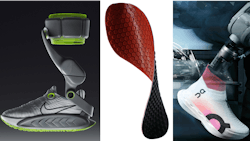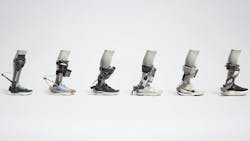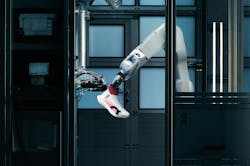Smarter Shoes: 3 Engineering Breakthroughs That Could Shape Future PPE
Key Highlights
- Nike's Project Amplify introduces a powered shoe that acts like a second set of calf muscles.
- SoleCooler's CLIMFEET insoles use thermodynamics to passively heat or cool feet without electronics.
- On's LightSpray technology enables shoes to be manufactured in minutes through robotic spraying, reducing waste and assembly time.
- The integration of these technologies into industrial settings could lead to lighter, more adaptable, and energy-efficient safety gear.
It's been a minute since footwear has made news for genuinely interesting engineering—or so I thought. The last time I remember shoes being the talk of the town was a few years ago, when companies like Jabil and DIYers alike were touting 3D-printed shoes. This week, I came across a new Nike invention, which led me down a rabbit hole of other notable shoe engineering feats from the past couple of years. So let's talk about three new footwear innovations—and the potential implications they could have for industry PPE in the future.
1. Nike's Robotic Shoe: Project Amplify
Nike is renowned for pushing the boundaries of footwear, especially in its running shoes. I still think back to the Pegasus 36 and its beautifully smooth Cushlon foam, paired with full-length Zoom Air. That combo made running truly feel effortless, helping your foot roll naturally forward with every stride. I'm still a little bitter that Nike moved away from that setup in favor of the springier React foams and stripped-down Zoom Air tech—but such is the nature of innovation and competition. When you're at the top, you have to keep reinventing.
And Nike's at it again. Only this time, it's not about making you faster—it's about helping you go farther (okay, maybe a bit faster too).
Project Amplify, the world's first powered footwear for running and walking, acts like a second set of calf muscles, augmenting the natural motion of your lower leg and ankle. Built on motion algorithms developed by the Nike Sport Research Lab, Project Amplify integrates a lightweight motor, drive belt, and rechargeable cuff battery into a carbon fiber–plated running shoe, designed to be worn with or without the robotic assist.
The shoe is still in testing, with Nike collaborating with robotics company Dephy to bring it to market in the coming years. Nike hasn't shared a launch date yet, but the concept is already generating buzz.
"We’ve always believed movement is medicine, and Project Amplify is the next chapter in that story. It’s a bold leap forward, crossing a new threshold of putting power directly into your stride," said Michael Donaghu, VP of Create The Future, Emerging Sport and Innovation, Nike.
Like the powered hiking exoskeleton I wrote about a few months ago, this innovation goes far beyond elite sports. It could help anyone who struggles to stay active—whether from age, injury, or fatigue—by taking some of the load off and extending their time on their feet.
It's also worth noting that Nike isn't pitching this as a performance hack for shaving seconds off your personal best. Instead, it's for those who want to move with less effort and more endurance. According to the company, testing with athletes of all levels shows the system feels natural—almost like it's part of the body—and makes walking or running uphill feel like moving on flat ground. Some runners even reported cutting their mile pace from 12 minutes to 10.
And then there's this perfect reminder at the bottom of Nike's announcement:
“If you have a body, you are an athlete.”
So don't think these new tech shoes aren't for you, because they're for anyone who could use them.
2. SoleCooler's CLIMFEET: Insoles That Warm or Cool With Every Step
As you get older, shoes become more about comfort than style. One shoe I have yet to find is a good winter boot that actually keeps my toes warm when it’s freezing outside. I either end up with socks that are so thick I can barely move my foot, or too thin and my toes turn into icicles. And it seems SoleCooler, a French company, has engineered the exact thing that could solve this problem.
The solution is CLIMFEET, silicone insoles that can heat or cool your feet without using any electronics, batteries, or chemicals. The innovation relies entirely on thermodynamics. Inside each insole is a network of air-filled cushion cells and copper-enhanced material that reacts to the pressure of your step. When you press down, the air compresses and warms slightly; when you lift your foot, it expands and cools. The result: one side of the insole can raise the temperature by about 4°C, while the reverse side can cool it by roughly 3.5°C—all powered by your own movement.
The design is clever. At just 6 mm thick, the insoles can fit inside most shoes without altering the structure, and the thermally conductive silicone and copper materials are built for durability. With no external power source, there’s nothing to charge, replace, or wire up—the mechanics do all the work passively.
3. On's LightSpray: Shoes Made in Minutes
We've already looked at some interesting footwear today, but I don’t think I’ve ever seen one literally sprayed into existence. Leave it to On to take "lightweight construction" to an entirely new level.
The Swiss running brand On is testing out a radical new way to make shoes—by spraying them. Its latest concept, the Cloudboom Strike LS, uses what On calls LightSpray technology: a robotic arm that sprays a continuous filament of elastic thermoplastic polyurethane (TPU) around a foot-shaped mold, building the entire upper in one seamless layer. No stitching, no knitting, no foam padding—just a single, flexible shell that forms right around the shape of the shoe.
The process is pretty fast. On claims a full upper can be made in about three minutes, compared to the hours or even days of work that go into traditional running shoe construction. Once formed, the upper is welded directly onto the sole unit, eliminating the need for adhesives and drastically reducing material waste and assembly steps.
The Cloudboom Strike LS made its debut around the 2024 Paris Olympics, worn by On-sponsored athletes as a showcase of the company's manufacturing ambitions. While this first version targets elite performance footwear, the technology itself points to something bigger. A process that can 3D-spray and bond materials in minutes could completely reshape how shoes—and potentially other flexible products—are manufactured at scale.
It's a good reminder that some of the most meaningful innovations are more about the thought process behind them rather than the end performance.
The Bigger Picture: What This Means for PPE
While each of these innovations are clearly tied to the athletic world, they all point toward something much bigger for the manufacturing and industrial sectors. The same engineering that's helping runners go farther, stay cooler, or build shoes faster could easily carry over into personal protective equipment—especially footwear.
A safety boot that could actively reduce fatigue, like Nike's Project Amplify, helps workers stay on their feet longer with less strain. Or a work shoe that regulates temperature naturally, like SoleCooler's CLIMFEET, keeping feet comfortable in extreme heat or cold without the need for powered components. Even On's LightSpray process has serious implications: a shoe that can be made in minutes with fewer materials and adhesives could completely rethink how safety footwear is produced—faster, lighter, and with less waste.
These kinds of breakthroughs show how consumer innovation can often open the door for industrial change. When a technology proves useful, scalable, or efficient for the masses, it tends to find its way into the workplace—especially when it offers comfort, safety, or performance gains. The engineering behind each of these footwear feats can act as a blueprint for showing what's possible when motion, materials, and manufacturing come together in new ways. Whether it’s Nike's powered movement assist, SoleCooler's passive thermal regulation, or On's rapid, glue-free construction, each idea hints at how future PPE or industrial products could be designed.
About the Author
Laura Davis
Editor-in-Chief, New Equipment Digest
Laura Davis is the editor in chief of New Equipment Digest (NED), a brand part of the Manufacturing Group at EndeavorB2B. NED covers all products, equipment, solutions, and technology related to the broad scope of manufacturing, from mops and buckets to robots and automation. Laura has been a manufacturing product writer for eight years, knowledgeable about the ins and outs of the industry, along with what readers are looking for when wanting to learn about the latest products on the market.



